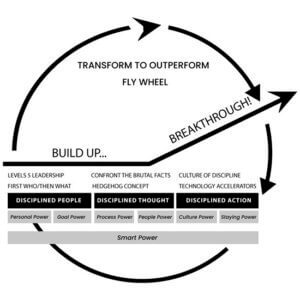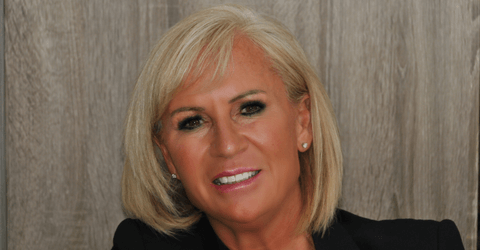As we wrestle with the conundrum of how to outperform amid global unrest, surging inflation, skill, and supply shortages, we bemoan the absence of the charismatic leaders of the past. Where are all the eloquent, judicious, and great leaders when we need them most? This wistful question caused me to look closely at how different leaders in recent history transcended extraordinary challenges to deliver outstanding results. The short answer is these heroes of our nostalgia developed their superpowers at a particular time suited to the extraordinary challenge of their day. Whilst we may have a crisis of confidence, today belongs to us, with whatever exceptional strengths we can summon to conquer our own extraordinary situation and summon them we must. For better or worse, we are the leaders charged with navigating this storm. Jim Collins’ revered book Good to Great set the baseline on principles required for outperformance and a model against which I surfaced seven underpinning powers.

The Flywheel Effect
Collins identified the capabilities demonstrated by a limited number of companies on the road to becoming good, and the breakthrough moment he called the Flywheel Effect, which led them to greatness – sustained industry outperformance. Imagine the heavy flywheel in an engine, it takes a lot of hard work to build speed, for scant reward; that is until momentum creates excess energy, and the wheel begins to spin ever faster without additional effort. To build this momentum in the business, Collins determined that organizations must be led by humble, deeply committed, professional leaders who carefully select the right people and technology; then with unbending discipline, they pursue a strategy built on a single unifying idea of what their organization can become best at in the world. Amazon’s Jeff Bezos for example, whilst famous now, did not fit the archetypal charismatic celebrity leader profile; he was compelled by an ambition to build the Everything Store, and carefully selected the technology, people, and process that could make it happen as he applied the seven powers.
Personal Power
Personal power is the influence we garner when we know our strengths, personality advantages, and unique differences and we use this knowledge to reframe how we engage with the world. It’s self-awareness on steroids. When we understand and more importantly, amplify these qualities, that’s when we do our best work. If you want to thrive and inspire as we stand at the foothills of global recession, unlock your personal power and influence through conviction and performance excellence. This ability to connect with your passion, transform internally and commit to deep personal mastery will ensure you meet a context in which to create your own masterpiece. Personal power is being ‘on your game’ like never before.
Goal Power
To activate personal power, we need goal power – an inspiring vision of a transformed world. The essence of goal power is razor-sharp goals, dynamically tracked; this marking of progress toward a goal or vision is the single most effective method of supercharging motivation. Whether Jeff Bezos, Steve Jobs, or Nelson Mandela, these leaders were hooked by a purpose, very early in their journey; they reinvented continually and mastered their context in pursuit of an extraordinary vision; they understood the hypnotic power of words to connect with emotions, bring a vision to life and mobilize collective effort.
Process Power
Are you wrestling with productivity as costs spiral, tackling unrest and exorbitant living costs, and trying to maintain earnings as recession bites? Are you doing more and achieving less? Instead of doing more with the same, see this disruption as a signal to transform your business model. Process power is where we design optimal tools and processes and map out and design change, it’s the methodical, disciplined implementation. Successfully transformed outcomes depend on world-class change management, the strict adoption of a well-designed process, and rapid, collective behavior change. Outmaneuver disruption by building a team who can turn their attention with the speed and adaptability of an ant army, working together to modify their environment, exploit resources and defend themselves!
People Power
The great myth of leadership is that of the lone warrior; leadership is a shared endeavor. When we create the right conditions for our people and share leadership, a performance double helix occurs between leader and team. Together, we achieve proficiency and performance greater than the sum of individual contributions – people power. We are currently witnessing a paradoxical change in the relationship between employees and work, most notably post Covid restrictions and driven by changing migration patterns, technology, and geo-political influences. This calls for a new leadership and engagement paradigm. The employee’s need for connection with their boss is more pronounced than ever. To release people’s power, we must personalize the leadership relationship and create exceptional work experiences, just as we personalize the customer relationship. Tune into increasingly diversified needs and contract with employees flexibly, to reflect the emerging new shape of the workforce. Build respect, prestige, and professionalism around the so-called ‘dirty jobs’ that are increasingly being left unfilled yet provide the services that make the civilized life we live.
Culture Power
The activation and amplification of leadership potential with goal power, the disciplined implementation of tools and processes, and the turbo boost created by people power are the cogs that rotate toward culture power – the excess energy that makes the flywheel turn. Cultural power is released when leaders focus on accountability and excellence, when they place their employees at the heart of their decision-making and energize them to act in the interests of the customer. An intangible force builds over time enabling intuitive communication and unconscious learning which increases speed, agility, and creativity. Amazon’s story began with passion and ingenuity – the personal power, staying power, and smart power of a leader who applied goal and process power to design the customer experience that we now know well. The Amazon flywheel kicked in when a culture of customer obsession, ownership, and innovation intensified people’s power causing ever-increasing momentum and an agile team who are difficult to beat. Amazon’s culture has been scrutinized recently for alleged high-pressured accountability. It will be interesting to see whether Amazon tips the balance slightly in favor of people over accountability to achieve a more sustainable position.
Master the seven powers now to unearth and supercharge latent strengths in your organization and ensure your business does not become one of the inevitable unproductive casualties of the impending recession.
About the Author:
Susie Robinson FCIPD, DipCHyp, NLP (Prac) QCHPA (reg) CNHC is a consultant and expert in the field of HR and Talent Management, with 35 years of professional experience having worked as a top executive in global companies. Before founding her company to create solutions that help clients activate game-changing outperformance, Susie held the role of Executive Vice President – Europe, Middle East, Africa, and Global Talent Leader for DHL Supply Chain. In this and preceding roles, she developed and delivered HR strategy, led successful transformation, and world-class HR teams, and sourced and developed talent at every level of organization in several countries around the world.







